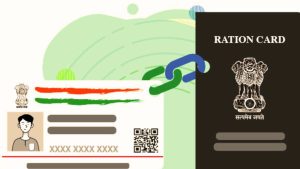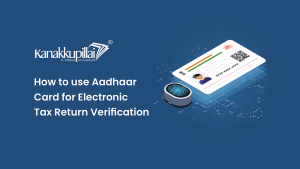![]()
Earlier in 2010, the Unique Identification Authority of India (UIDAI), a central government organization, proposed the notion of giving each person of the nation a unique number after gathering and storing their biometric values. That is what they referred to as an Aadhaar card. In addition, with the cardholder’s fingerprint, iris, and other biometrics, the Aadhaar card contains a 12-digit number. The goal of Aadhaar is to give all Indian citizens, including immigrants and refugees, access to a universal identity infrastructure.
The usage of Aadhaar is not intended to take the place of PAN, passports, driving licences, or other forms of identity. However, it may be utilized as a single form of identification. It also acts as a method of identity verification for numerous other, both government and private services.
As a result, Aadhaar has become known as India’s most crucial identity document. It is, therefore, impossible to underline the importance of linking the bank account with the Aadhaar card.
According to a Supreme Court decision issued in September 2018, people are not required to link their Aadhaar number to their bank account. But if they want to, users are able to link their Aadhaar with their bank accounts either online or offline.
Although it is not required, linking your bank account to your Aadhaar card is advantageous. It enables you to have reliable identity documentation and serves as KYC for all of your online payment methods, including UPI payments. It has made it simpler for the government to distribute subsidies along with advantages directly to the intended recipients, as well as reduced corruption and the use of fraudulent and duplicate accounts. Furthermore, it has improved banking accessibility for the less fortunate segments of society who previously lacked valid identification documents.
We will go over how to effortlessly link your Aadhaar number to your bank account through this article using a variety of techniques, including internet banking, phone, ATM, etc. This generic step-by-step approach would be helpful in most situations, even if the procedure might differ slightly based on your bank. Let’s begin!
Benefits of Linking Aadhaar Card with a Bank Account
UIDAI states on their website that linking an Aadhaar card to a bank account increases a citizen’s level of security. In this manner, it will be impossible for someone to pretend to be you to access your bank account or funds. Banks are frequently given false identities by fraudsters, who typically open accounts and engage in fraudulent activities.
However, when an individual’s Aadhaar card is connected to a bank account, their identity is unquestionably confirmed. Just to make sure of it, e-KYC takes place. Here there are some benefits listed below:
Eligibility for Government Subsidies: There was a period when a substantial amount of government subsidies never made it to the intended recipients. Due to widespread corruption and improper financial handling, many economic sectors failed to develop and advance. However, there has been a noticeable improvement in the distribution of subsidies to people who actually need them as a result of the adoption of modern technologies and transparency measures. As a result, it linked both the plan and the bank account to Aadhaar. Several government schemes either already have Aadhaar links or are in the process of doing so. Let’s examine a few of the following schemes:
Emeritus Fellowship: UGC provides honorarium and contingency grants to highly qualified, experienced or superannuated teachers who link their Aadhaar and bank accounts.
Aam Aadmi Bima Yojana: Rural landless households can receive insurance and disability benefits through the Aam Aadmi Bima Yojana, but individuals must link their Aadhaar and bank accounts.
Cash Transfer of Food Subsidy Rules: In accordance with the Cash Transfer of Food Subsidy Rules, 2015, the government links ration cards and Aadhaar in order to transmit subsidy funds to BPL-eligible, underprivileged people who have linked bank accounts with Aadhaar.
Direct Benefits Transfer: DBT transfers subsidy funds from programmes like Pahal and other Central Government-sponsored schemes into beneficiaries’ bank accounts.
Pradhan Mantri Ujjwala Yojana: According to the Pradhan Mantri Ujjwala Yojana (PMUY), women of BPL households can apply for a new LPG connection and receive a subsidy amount directly to their bank account, verified using Aadhaar, as per the Direct Benefit Transfer Scheme.
Streamlined KYC process: The KYC procedure is essential for preventing fraud, money laundering, and the financing of terrorist activity. Banks, financial institutions, and other companies use KYC information to ensure that their customers are who they claim to be. It entails gathering and confirming the client’s personal data, mostly utilizing the Aadhaar card, including name, place of residence, date of birth, and government-issued identification documents.
Verifying this data ensures the accuracy of the information the customer has submitted. With the e-KYC service, paperless transactions will benefit from the efficiency and power of Aadhaar KYC. Residents can provide UIDAI permission to give a service provider access to their KYC data by using the e-KYC service. The following list outlines the purposes of utilizing the KYC process with Aadhaar:
- By confirming its clients’ identity and ensuring that their money isn’t being used for criminal activity, it aids financial institutions in stopping money laundering activities.
- By confirming the accuracy of the customer’s personal information and their identification, it aids organizations in preventing fraud.
- It is a necessity under Indian law to create a bank account, apply for a quick personal loan, or invest in securities.
- It protects customers’ interests by making sure their personal information is secure and not exploited.
- The experience for customers might be made more efficient. The KYC procedure may not need to be repeated in the future for new financial activities or transactions by the same consumer once a distinctive customer identity number has been created.
Easy access to various financial services: Identifying the customer is the main difficulty that financial organisations encounter. In particular, banks must ensure that no money is being laundered through accounts formed with fictitious documentation before accepting deposits.
To address this issue, financial institutions increasingly rely on modern technology such as biometric authentication and digital identity verification using Aadhaar, which can reliably authenticate customers’ identities and detect suspicious activity in real-time. These innovations offer a smooth user experience while also enhancing security. Following is a list of some advantages that come with linking bank accounts and Aadhaar, which makes it simple to get financial services:
- Providing services such as account opening at the customer’s doorstep is advantageous.
- The bank claims to have made it possible for clients of more than 20,000 fair-pricing stores to pay for their rations directly from a linked bank account through “Aadhaar Pay.”
- Customers can anticipate employing biometrics to operate lockers and ATMs in addition to making retail transactions. Therefore, they won’t need to remember passwords because of Aadhaar linking at PoS, ATM networks, and Internet banking channels.
- The use of Aadhaar will allow for the transition of all banking services to the ATM channel. The 60,000 or more ATMs with biometric capabilities were installed between 2012 and 2017. As a result, ATMs can be used for all branch transactions, including money transfers, utility bill payments, processing loan applications, your phone top-ups, and wallet recharges.
- It will take less time to issue insurance policies and resolve disputes. The CKYC procedure will be streamlined by linking Aadhaar/PAN to bank accounts, strengthening the customer’s identity and, to some extent, streamlining claim processing.
- By referencing the Aadhaar number in the proposal form and retrieving bank information, linking the Aadhaar and PAN will enable early claim settlement. So it would be simpler to credit the funds.
Methods to Link Aadhaar Card to Bank Account
There are several ways to connect your bank account with an Aadhaar card. Here are a few of them:
Online Method
Steps to Link Bank Account with Aadhaar through Internet Banking
Following is how to effortlessly use Internet banking to link your bank account with your Aadhaar:
Step 1: Access your bank’s online banking by logging in to your account.
Step 2: Access your account using the credentials, like username and password.
Step 3: Select “Update Aadhaar with Bank Accounts (CIF)” from the “My Account” section.
Step 4: To register for an Aadhaar, enter your profile password.
Step 5: You will be requested to enter twice your Aadhaar number on a new page that will open.
Step 6: Upon providing your Aadhaar number, select the “Submit” button.
Step 7: A notification will be displayed when your Aadhaar is successfully seeded.
Steps to Link Bank Account with Aadhaar Through Mobile App
Using their mobile apps, many banks let you connect your bank account to your Aadhaar number. The typical steps you must take are listed below:
Step 1: Get the respective mobile banking app by visiting the App Store or Google Play Store.
Step 2: Open the application and log in using your account details. Complete any security checks if there are any.
Step 3: Select “Requests”/ “Service Requests” or any other form by clicking on it.
Step 4: You should choose “Link Aadhaar” or “Update Aadhaar Number” or whatever other variation.
Step 5: Choose the account you want to link your Aadhaar to.
Step 6: Type in your Aadhaar number (you might be prompted to do it again for verification).
Step 7: Whenever relevant, agree to the terms and conditions.
Step 8: Choose “Update, ” or “Confirm,” or another alternative.
Offline Method
Steps to Link Aadhaar Card with bank accounts through bank branch
If the aforementioned steps are unsuccessful or if a person does not have access to net banking, they can physically visit the relevant bank branch and complete the Aadhaar and bank account link process by doing as follows:
Step 1: Upon a visit to your bank branch, you must complete an application for “Aadhaar linking.”
Step 2: Enter your Aadhaar number and bank account information without making any mistakes.
Step 3: For submission, you must have a self-attested duplicate of your original Aadhaar with you.
Step 4: After 24 hours of submitting the form, you can expect updates through SMS to the registered contact number on your account.
Step to Link Aadhaar Card with Bank Account through SMS
The Aadhaar number and bank account can also be linked via SMS; however, to do so, the account user needs to send a text message to a specific number that the respective bank includes.
Step 1: The following format must be used while writing your message: Aadhaar Number<space>UID<space>Account Number.
Step 2: As soon as your request is approved, you will be notified immediately through text message.
(In the meantime, the bank will verify the information with UIDAI,)
Step 3: In the event that your verification is failed, you will be informed and told to visit the nearby bank office with your real Aadhaar card.
Steps to Link Bank Account with Aadhaar through Phonebanking
If your bank offers phone banking, you might be able to use this approach to link your Aadhaar and bank account. The primary steps for linking an Aadhaar card to a bank account over the phone are as follows:
Step 1: Make a missed call to the contact number your bank gave if it enables Aadhaar seeding over the phone.
Step 2: The bank will contact you back, and you can make choices from the IVR during that call.
Step 3: Type in and verify your 12-digit Aadhaar number.
Step 4: Once your Aadhaar has been linked to your account, a text message will be sent to you.
Steps to Link Bank Account with Aadhaar Using ATM Machine
In addition, going to an ATM will allow you to link your Aadhaar number to your bank account. If you want to use your debit card at an ATM to link your Aadhaar number to your bank account, adhere to the steps below:
Step 1: At the ATM machine, swipe the debit card you are using and input the PIN.
Step 2: Choose the “Services” option from the menu that appears on the screen.
Step 3: In the next step, choose “Registration” next, then “Aadhaar Registration.”
Step 4: Your 12-digit Aadhaar number should be entered, which will need to be entered twice for verification.
Step 5: Click “Okay” (or a similar button) on the ATM screen. The display will show you the confirmation message when your Aadhaar number and your bank account have been successfully linked.




